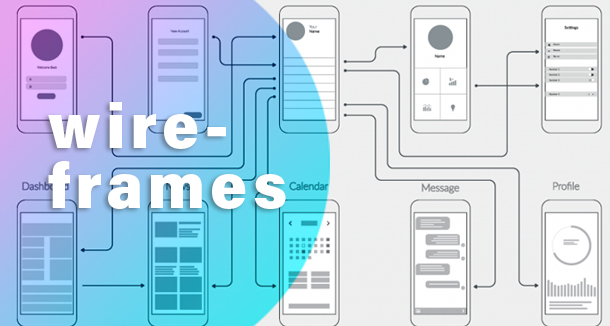A Website wireframe, also known as a page schematic or screen blueprint, is a visual guide that represents the skeletal framework of a website. Wireframes are created for the purpose of arranging elements to best accomplish a particular purpose. The purpose is usually being informed by a business objective and a creative idea. The wireframe depicts the page layout or arrangement of the website’s content, including interface elements and navigational systems, and how they work together. The wireframe usually lacks typographic style, color, or graphics, since the main focus lies in functionality, behavior, and priority of content. In other words, it focuses on what a screen does, not what it looks like. Wireframes can be pencil drawings or sketches on a whiteboard, or they can be produced by means of a broad array of free or commercial software applications. Wireframes are generally created by business analysts, user experience designers, developers, visual designers, and by those with expertise in interaction design, information architecture and user research.
Wireframes focus on:
- The range of functions available
- The relative priorities of the information and functions
- The rules for displaying certain kinds of information
- The effect of different scenarios on the display
The website wireframe connects the underlying conceptual structure, or information architecture, to the surface, or visual design of the website. Wireframes help establish functionality and the relationships between different screen templates of a website. An iterative process, creating wireframes is an effective way to make rapid prototypes of pages, while measuring the practicality of a design concept. Wireframing typically begins between “high-level structural work—like flowcharts or site maps—and screen designs. Within the process of building a website, wireframing is where thinking becomes tangible.
Wireframes may have multiple levels of detail and can be broken up into two categories in terms of fidelity, or how closely they resemble the end product.

Low-fidelity
Resembling a rough sketch or a quick mock-up, low-fidelity wireframes have less detail and are quick to produce. These wireframes help a project team collaborate more effectively since they are more abstract, using rectangles and labeling to represent content. Dummy content, Latin filler text (lorem ipsum), sample or symbolic content are used to represent data when real content is not available. For example, instead of using actual images, a placeholder rectangle can be used.
Low-fidelity wireframes can be used to facilitate team communication on a project and is used in the early stages of a project.
High-fidelity
High-fidelity wireframes are often used for documenting because they incorporate a level of detail that more closely matches the design of the actual webpage, thus taking longer to create.
For simple or low-fidelity drawings, paper prototyping is a common technique. Since these sketches are just representations, annotations—adjacent notes to explain behavior—are useful. For more complex projects, rendering wireframes using computer software is popular. Some tools allow the incorporation of interactivity including Flash animation, and front-end web technologies such as, HTML, CSS, and JavaScript.
High fidelity wireframes include more real content, specific typography choices, and information on image dimensions. Unlike low fidelity wireframes, high fidelity wireframes can include actual images. Color choices are not included, but different values in color can be represented in grayscale.
The above is a brief gathered from few sites about Wireframes. Watch this space for more updates on trends in Technology.
